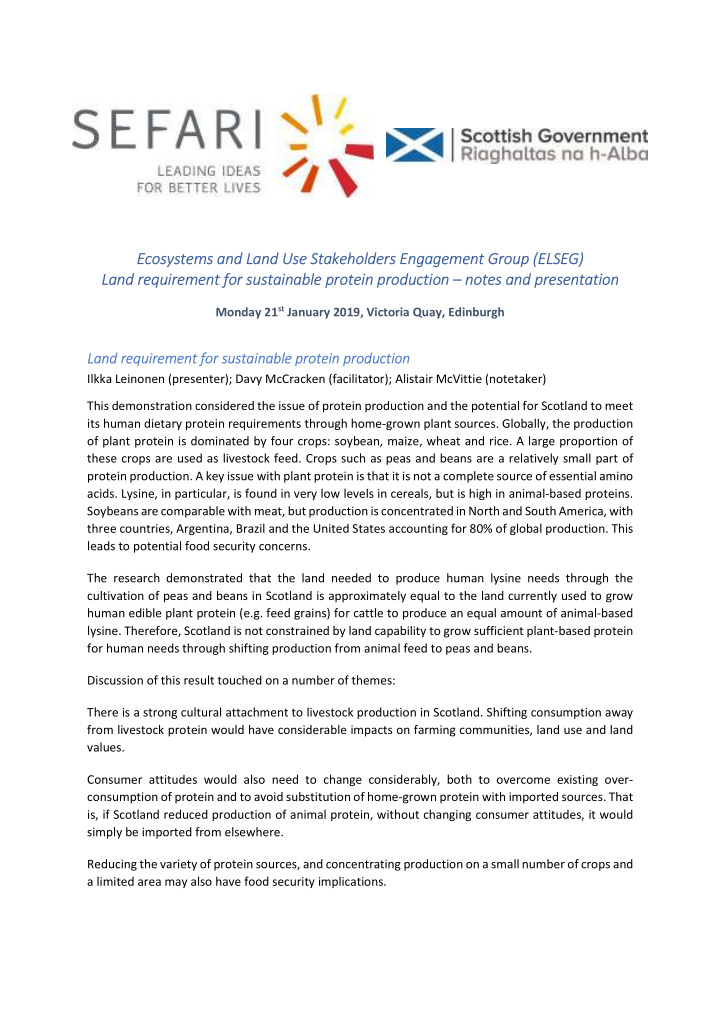



Ecosystems and Land Use Stakeholders Engagement Group (ELSEG) Land requirement for sustainable protein production – notes and presentation Monday 21 st January 2019, Victoria Quay, Edinburgh Land requirement for sustainable protein production Ilkka Leinonen (presenter); Davy McCracken (facilitator); Alistair McVittie (notetaker) This demonstration considered the issue of protein production and the potential for Scotland to meet its human dietary protein requirements through home-grown plant sources. Globally, the production of plant protein is dominated by four crops: soybean, maize, wheat and rice. A large proportion of these crops are used as livestock feed. Crops such as peas and beans are a relatively small part of protein production. A key issue with plant protein is that it is not a complete source of essential amino acids. Lysine, in particular, is found in very low levels in cereals, but is high in animal-based proteins. Soybeans are comparable with meat, but production is concentrated in North and South America, with three countries, Argentina, Brazil and the United States accounting for 80% of global production. This leads to potential food security concerns. The research demonstrated that the land needed to produce human lysine needs through the cultivation of peas and beans in Scotland is approximately equal to the land currently used to grow human edible plant protein (e.g. feed grains) for cattle to produce an equal amount of animal-based lysine. Therefore, Scotland is not constrained by land capability to grow sufficient plant-based protein for human needs through shifting production from animal feed to peas and beans. Discussion of this result touched on a number of themes: There is a strong cultural attachment to livestock production in Scotland. Shifting consumption away from livestock protein would have considerable impacts on farming communities, land use and land values. Consumer attitudes would also need to change considerably, both to overcome existing over- consumption of protein and to avoid substitution of home-grown protein with imported sources. That is, if Scotland reduced production of animal protein, without changing consumer attitudes, it would simply be imported from elsewhere. Reducing the variety of protein sources, and concentrating production on a small number of crops and a limited area may also have food security implications.
The analysis only considered land use change. However, there will also be important greenhouse gas impacts from shifting protein production from animal to plant sources. It was noted that cattle production could be more efficient in land use terms if grazing was supplemented with the use of distillery by-products, however, these are increasingly being diverted to renewable energy production. Wider impacts were also recognised. Increased cultivation of peas and beans would require pollination and the need to ensure adequate pollinator habitats. The production of nitrogen fixing crops would also reduce nutrient inputs with potential benefits for water quality.
Appendix 1 - Presentations The following pages show the land requirement presentation slides
Land requirement for sustainable protein production Ilkka Leinonen SRUC 21/01/2019 1
Background: global protein production 2 2 Sources: FAOSTAT, USDA etc.
Background: quality of protein is critical • Daily protein intake must contain a sufficient amount of all essential amino acids – Phenylalanine – Valine – Threonine – Tryptophan – Methionine – Leucine – Isoleucine – Histidine – Lysine (low in cereals) 3 3
Getting lysine and other essential amino acids from food Total protein intake, g/day Energy intake, kJ/day 100 18000 90 16000 80 14000 70 12000 60 10000 50 8000 40 30 6000 20 4000 10 2000 0 0 Egg Soya Broad Wheat, Wheat, Maize Rice 80% 70% Egg Soya Broad Wheat, Wheat, Maize Rice 80% 70% bean whole white bean + bean + bean whole white bean + bean + grain 20% 30% grain 20% 30% wheat wheat wheat wheat 4 4
Soya: main global source of plant-based lysine 5 5 Source: FAOSTAT
Protein production and demand in Scotland • Tool: Scottish Agricultural Emission Model (SAEM) – One of the few tools that can handle the whole livestock production chains • Input data: – Agricultural census and ERSA data on livestock numbers, area of crops and grassland, crop yields – Structure of Scottish livestock systems and data on animal performance (e.g. QMS, BPEX, poultry industry) – Feed information (e.g. Defra, livestock industry) – Protein and amino acid contents of products (e.g. USDA) • Outputs – Plant protein (and amino acid) production – Livestock demand for protein and other feed – Protein (and amino acid) outputs from different livestock systems 6 6
Protein production and use in Scotland, t/year 1400000 1200000 1000000 Human demand 800000 Distillery grains Grass 600000 Cereal 400000 Imported soya Other plant protein 200000 Animal protein 0 Total plant Human Protein Human Human protein edible used for edible demand plant livestock animal protein protein 7 7
Plant protein production in Scotland 8 8 (Source of spatial data: EDINA agcensus)
Potentially human edible protein in Scotland Livestock: primary lysine source 9 9 Sources: ERSA, EDINA agcensus etc.
Land use and lysine production in Scotland 10 10
Future of Scottish protein production? • GHG mitigation-> shift from animal protein to plant protein? • Should not compromise the quantity/quality of protein produced (e.g. lysine content) • Replacing animal-based lysine by plant-based lysine (beans and peas) grown in Scotland? – Land requirement: about 170 000 ha need to be converted to bean/pea production – This land can be released from current livestock feed production • Continuing low-input livestock production? – Utilizing land that is not suitable for human edible protein production • Increasing the use of by-products in livestock feeding? 11 11
Recommend
More recommend